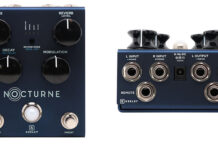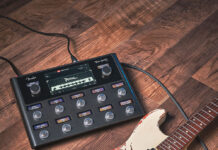Review: Taylor Guitars Academy Series 10e and 12e
GOLD AWARD
There are probably more good new acoustic guitars in the $500 and under street price range now than ever before in history (after adjusting for inflation, of course). As wonderful as this development appears on the surface, it also means that finding a truly great acoustic guitar in that price range may actually be a bigger challenge than ever.
Companies that primarily specialize in electrics and overseas mass producers often try to seduce first-time buyers by offering acoustics adorned with lots of flash and glitz like colorful finishes, shiny inlay work, and fancy electronics system with lots of knobs and flashing lights. As a result, more “plain Jane” instruments built by companies that specialize in acoustics often get overlooked by inexperienced buyers.
Taylor’s new Academy Series makes a bold case for why the name on the headstock should be a buyer’s primary consideration. It’s easy to build a good guitar by copying previous successful designs, but it takes a certain skill set and years of painstakingly developed know-how to build a great guitar within certain cost and material considerations.
The Academy Series models are not “dumbed down” budget versions of Taylor’s more expensive models, but rather entirely new designs developed to deliver the maximum potential for an acoustic guitar in this price range. They’re also brilliantly designed for maximum playing comfort under the knowledge that the first-time players who are most likely to buy these instruments will also be more likely to keep playing a guitar that’s easy to play and sounds good.
FEATURES
The Taylor Academy Series currently consists of three models—the steel-string 10e (dreadnought) and 12e (grand concert) flattops and the nylon-string 12e-N. For this review we looked at the steel-string models. With the exception of the different body dimensions and neck material (the 10e’s neck is sapele, while the 12e’s neck is mahogany), both the 10e and 12e share almost identical features.
Materials include a solid Sitka spruce top, layered sapele back and sides (a three-layer configuration consisting of sapele veneer on the outer edges and a poplar center layer), ebony fingerboard and bridge, Nubone nut, and Micarta saddle. Neck specifications include a 24 7/8-inch scale length, 20 frets, 1 11/16-inch nut width, and a slim profile with just a subtle hint of a rounded “v” peak at the center.
Both the Academy Series guitars have understated aesthetics that some might call austere but one could also call elegantly simple. There is no binding or purfling anywhere, and the only visual decorative elements are the three-ring rosette, 4mm Italian acrylic dot fingerboard inlays, and Taylor name on the headstock. However, one surprising feature is the armrest bevel on the lower bass bout—an ergonomic feature previously only found on much more expensive custom acoustics.
In another unusual departure for a Taylor acoustic-electric, the new ES-B pickup/preamp system features a built-in digital chromatic tuner in addition to the usual volume and tone controls.
PERFORMANCE
If even the most experienced acoustic specialist were to play Taylor’s Academy Series guitars blindfolded, I doubt that he or she would guess that they are instruments with street prices around $500. The playability is incredibly comfortable, and the tone completely outshines anything else in their class. The 10e delivers classic dreadnought tone with a powerful, assertive voice that is surprising considering its shorter scale length and that the guitar was strung with light-gauge strings.
The bass isn’t quite as boomy or big, but many players will consider this a bonus as the midrange is also slightly more prominent and sweeter—perfect for rock rhythm playing on stage without needing a bass cut filter. I can also attest that 20 years ago it was impossible to find a new guitar under $1,000 with tone as sweet as the 12e. This is a real honey for fingerstyle players with rich midrange, surprisingly voluptuous treble, and disciplined bass, but it’s also a great rhythm guitar for solo singer-guitarists.
Perhaps the tone of both models isn’t quite as harmonically complex or richly resonant as guitars costing five to ten times as much, but even discriminating players will certainly find the core base tone of both compellingly attractive.
LIST PRICE: $798
MANUFACTURER: Taylor Guitars, tayorguitars.com
• The solid Sitka spruce top has a special Academy bracing pattern that is voiced specifically to each model’s shorter scale length and light-gauge strings.
• Both the 10e and 12e have a 24 7/8-inch scale, 20 frets, 1 11/16-inch nut width, and slim neck profile with just a hint of a rounded “v” shape.
• Taylor’s new ES-B pickup/preamp system provides a built-in digital chromatic tuner with LED display.
• An armrest bevel in the lower bass bout provides enhanced playing comfort for players who rest their picking arm on the guitar’s top.
THE BOTTOM LINE
The Taylor Academy Series guitars may have “plain Jane” appearance, but guitarists of all levels of experience will find it hard not to fall in love with their sexy sound quality, comfortable playability, and impressive electronics.
Source: www.guitarworld.com











